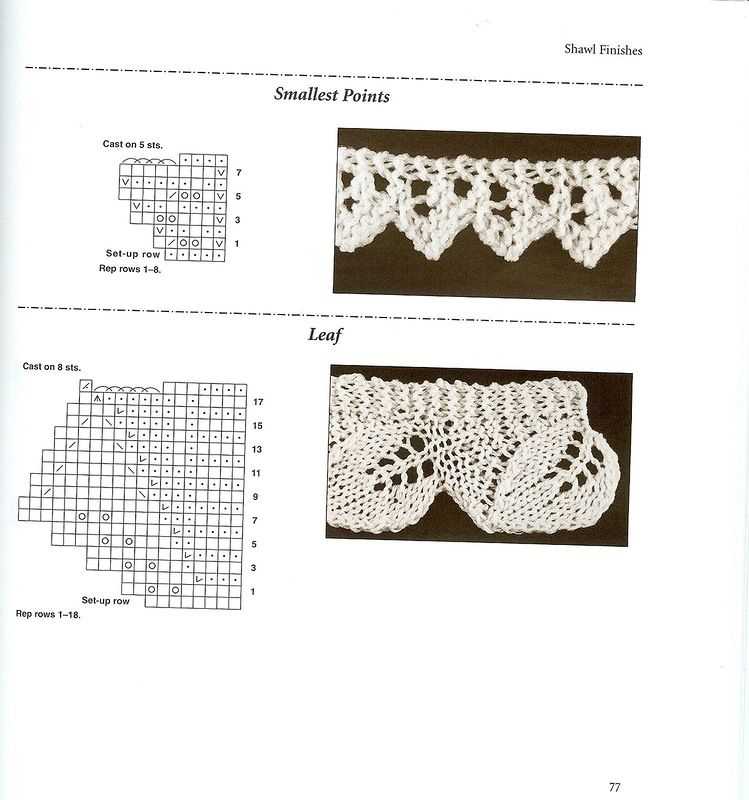
If you love adding a touch of elegance and intricacy to your shawl patterns, then knitted lace edging is the perfect technique for you. Knitted lace edging is a beautiful way to accentuate the edges of your shawls, providing a delicate and feminine touch to your finished project.
With various lace patterns and styles to choose from, knitted lace edging allows you to personalize your shawl patterns and bring your creative vision to life. Whether you prefer classic, traditional lace patterns or modern and unique designs, there is a lace edging pattern out there that will complement your style and make your shawl truly one-of-a-kind.
Knitted lace edging can be added to shawl patterns of any shape or size. From triangular and rectangular shawls to crescent and circular designs, the versatility of lace edging allows you to create stunning shawls for any occasion. Whether you’re knitting a shawl for a special event or simply to add a touch of elegance to your everyday outfits, knitted lace edging will take your shawl patterns to the next level.
Knitted Lace Edging for Shawl Patterns
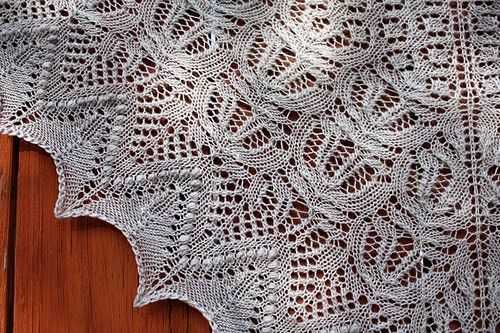
Knitted lace edging is a beautiful and intricate design element that can elevate any shawl pattern. It adds a delicate and feminine touch to the overall design, making it perfect for special occasions or everyday wear. Whether you’re an experienced knitter or just starting out, incorporating a knitted lace edging into your shawl pattern can take your knitting skills to the next level.
When choosing a knitted lace edging for your shawl pattern, it’s important to consider the overall style and aesthetic you want to achieve. There are various lace patterns to choose from, ranging from simple and classic to intricate and intricate. You can opt for a traditional lace pattern with floral motifs or experiment with more modern and geometric designs. The choice is yours, and it ultimately depends on your personal preference and the specific look you want to achieve.
Here are some factors to consider when incorporating a knitted lace edging into your shawl pattern:
- Lace pattern complexity: Decide on the level of difficulty you’re comfortable with. Some lace patterns are relatively easy to knit, while others require more advanced skills. Consider your knitting experience and choose a lace pattern that matches your skill level.
- Yarn choice: The type of yarn you use can greatly affect the overall look and feel of your knitted lace edging. Consider using a lightweight and fine yarn to create delicate and airy lace patterns, or go for a thicker yarn for a more substantial and textured look.
- Blocking: Blocking is an essential step in knitting lace, as it helps open up the lace pattern and give it a more defined and polished look. Make sure to block your shawl properly to showcase the intricate details of your knitted lace edging.
- Finishing touches: Once you’ve completed your knitted lace edging, you can further enhance its beauty by adding decorative elements such as beads, sequins, or embroidery. These embellishments can add extra dimension and create a truly unique and eye-catching piece.
Overall, knitted lace edging for shawl patterns is a wonderful way to add elegance and sophistication to your knitting projects. With a wide range of lace patterns to choose from and endless possibilities for customization, you can create stunning shawls that are both practical and stylish. So why not give knitted lace edging a try and take your shawl patterns to the next level?
Why add lace edging to shawls?
Lace edging is a popular choice for shawl patterns for several reasons. Firstly, it adds an elegant and delicate touch to the overall design. The intricate patterns created by lace knitting can create a beautiful and eye-catching border that sets the shawl apart from other accessories.
Furthermore, lace edging can also serve a practical purpose. The openwork created by lace knitting allows for better ventilation, making lace-edged shawls perfect for wearing in warmer climates or during the summer months. Additionally, the lightweight nature of lace knitting makes it a great choice for adding extra length to a shawl without adding bulk.
In terms of customization, lace edging offers endless possibilities. There are numerous lace stitch patterns to choose from, ranging from simple and beginner-friendly to more complex and challenging. This allows knitters to tailor the lace edging to their skill level and personal style.
Finally, lace edging can also be a way to add a finishing touch to a shawl. By adding a lace border, the shawl is given a polished and complete look. It can make even the simplest shawl pattern look more sophisticated and elegant, making it a perfect accessory for special occasions or as a gift.
Choosing the right lace pattern
When it comes to knitted lace edging for shawl patterns, choosing the right lace pattern can make all the difference. The lace pattern you choose will determine the overall look and feel of your shawl. It should complement the yarn and the design of the shawl, as well as enhance its beauty.
Consider the yarn: Different lace patterns work well with different types of yarn. For a delicate and airy look, choose a lace pattern that is open and has a lot of negative space. If you are working with a heavier yarn, a denser lace pattern with smaller motifs may be more appropriate.
Match the shawl design: Consider the overall design of the shawl and how the lace edging will fit into it. If the shawl has a simple and clean design, a more intricate lace pattern may be a beautiful addition. On the other hand, if the shawl already has a complex design, a simpler lace pattern may be a better choice to avoid overwhelming the overall look.
Think about the occasion: The occasion for which you are knitting the shawl can also influence your choice of lace pattern. For a formal event, a more intricate and elegant lace pattern may be fitting. For a casual and everyday shawl, a simpler and more playful lace pattern can add a touch of whimsy.
Experiment and have fun: Knitting lace edging for shawl patterns can be a creative and enjoyable process. Don’t be afraid to experiment with different lace patterns and combinations until you find the perfect one for your shawl. Remember to have fun and enjoy the journey!
Selecting the right yarn for lace edging
When it comes to selecting the right yarn for lace edging, there are a few important factors to consider. Firstly, the weight of the yarn will have a significant impact on the final result. A lighter weight yarn, such as lace weight or fingering weight, will create a delicate and intricate lace design. On the other hand, a heavier weight yarn, like sport weight or worsted weight, will result in a more substantial and textured lace edging.
Another consideration is the fiber content of the yarn. Natural fibers, such as wool or silk, are often preferred for lace knitting because they have great stitch definition and drape beautifully. However, synthetic fibers like acrylic or nylon can also be used, especially if you’re looking for a more affordable or low-maintenance option. It’s also worth noting that certain fibers, such as mohair or alpaca, can add extra softness and fuzziness to the lace edging.
Here are some key points to consider when selecting yarn for lace edging:
- Weight: Choose a yarn weight that matches the desired look and feel of the lace edging.
- Fiber content: Decide whether you prefer natural or synthetic fibers, considering their stitch definition and drape.
- Texture: Consider using yarns with added texture, like mohair or boucle, to enhance the visual interest of the lace edging.
- Color: Select a color that complements the main shawl pattern and enhances the overall aesthetic appeal.
- Yardage: Ensure that you have enough yarn to complete the desired length of the lace edging without running out.
In summary, choosing the right yarn for lace edging involves considering the weight, fiber content, texture, color, and yardage requirements. By carefully selecting these elements, you can create a beautiful lace edging that perfectly complements your shawl pattern.
Sizes and dimensions for lace edging
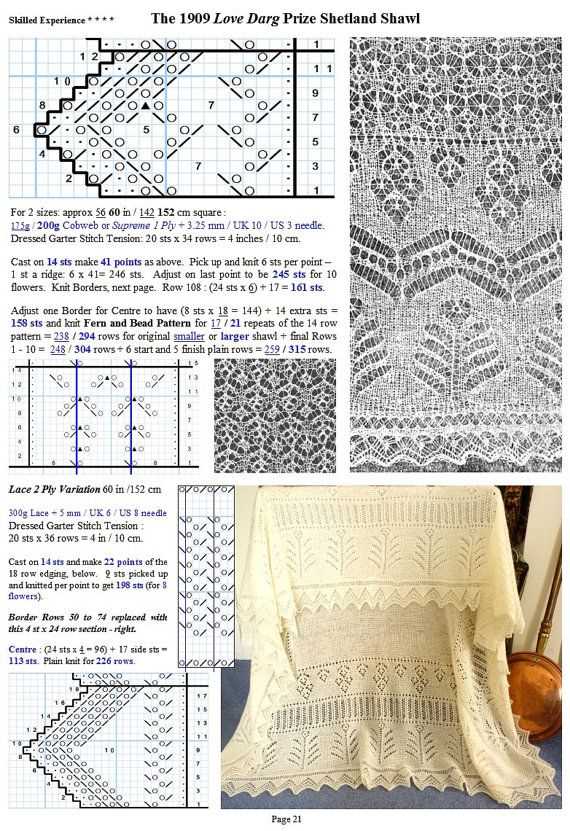
When adding lace edging to your shawl pattern, it is important to consider the size and dimensions of the edging to ensure the desired effect and fit. The size of the edging will depend on the overall size of your shawl and the desired level of detail. Here are some guidelines to help you determine the appropriate size and dimensions for your lace edging:
1. Shawl size:
Consider the size of your shawl when determining the size of the lace edging. If you have a larger shawl, you may want to opt for a wider lace edging to create a more dramatic and eye-catching effect. For a smaller shawl, a narrower lace edging may be more appropriate to maintain a delicate and elegant look.
2. Pattern repeat:
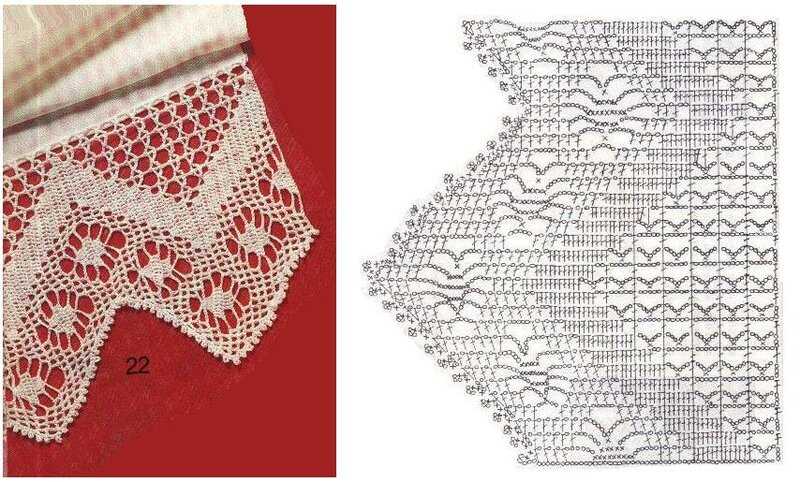
Take into account the pattern repeat of your chosen lace edging design. Some lace patterns have a shorter repeat, which means you may need to repeat the pattern multiple times to achieve the desired length. Other patterns have a longer repeat, which may require fewer repetitions. Consider the desired length of your lace edging and calculate the number of repeats needed accordingly.
3. Yarn weight and gauge:
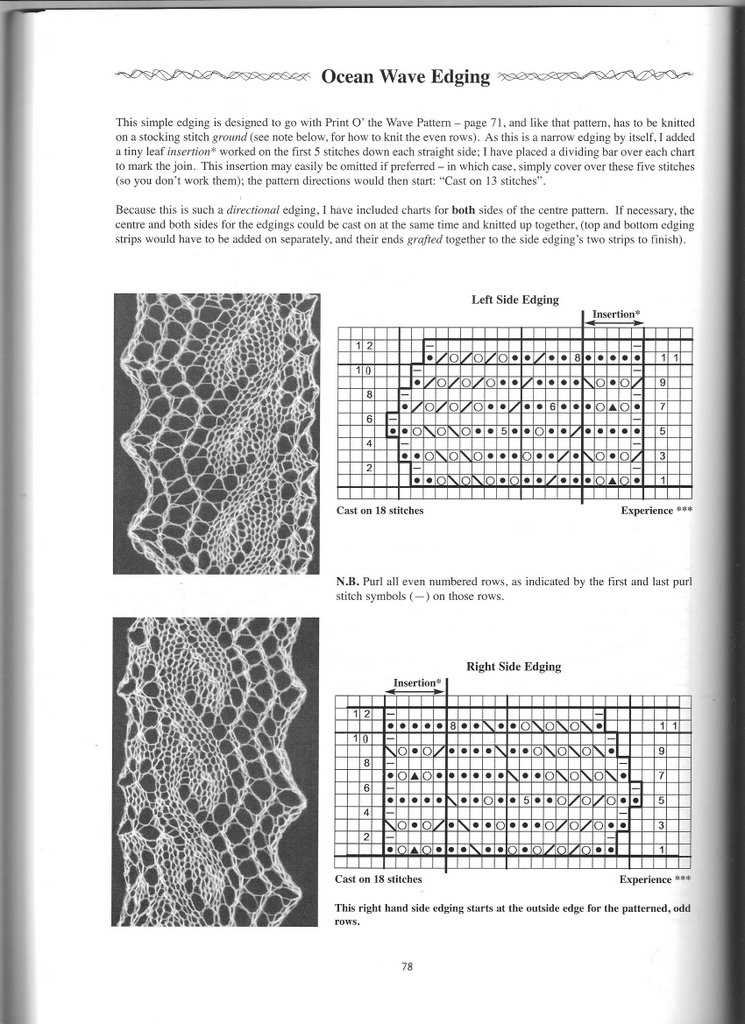
The weight and gauge of your yarn will also impact the size of your lace edging. Thicker yarns will create a bulkier and more substantial edging, while thinner yarns will result in a more delicate and intricate look. Additionally, the gauge or tension of your knitting will affect the overall size of the lace pattern. Be sure to swatch and adjust your needle size and tension as needed to achieve the desired size and dimensions of your lace edging.
4. Blocking:
Don’t forget to consider the blocking process when determining the size and dimensions of your lace edging. Lace patterns often require blocking to open up the stitches and showcase the intricate details. Blocking can significantly affect the final dimensions of your lace edging, so it is important to account for this during the knitting process. Be sure to measure your lace edging after blocking to ensure the desired size and dimensions are achieved.
By taking into account the size of your shawl, the pattern repeat, yarn weight and gauge, as well as the blocking process, you can determine the appropriate size and dimensions for your lace edging. Whether you want a wide and dramatic border or a delicate and intricate design, careful consideration of these factors will ensure the perfect finishing touch to your shawl pattern.
Basic techniques for knitting lace edging
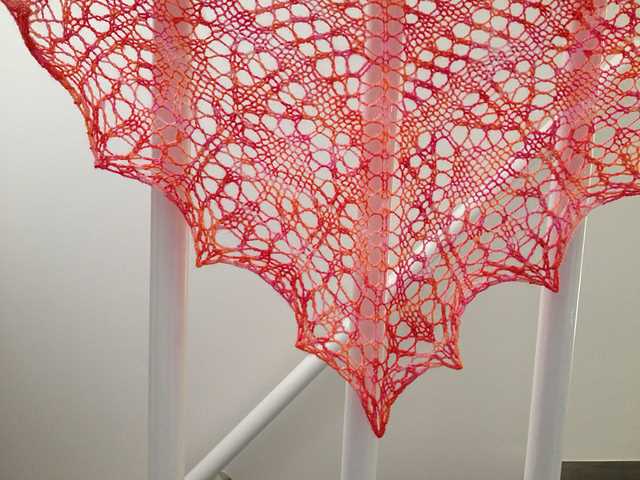
Knitting lace edging for shawls can add a beautiful and delicate touch to your finished projects. Learning some basic techniques for knitting lace edging can help you create intricate and stunning designs. Here are a few key techniques to keep in mind:
1. Yarn overs:
Yarn overs are an essential technique in lace knitting as they create the holes and spaces that give lace its airy and light appearance. To work a yarn over, simply bring the yarn to the front of your work, then over the right-hand needle to the back. This creates an additional stitch and a hole in your knitting.
2. Decreases:
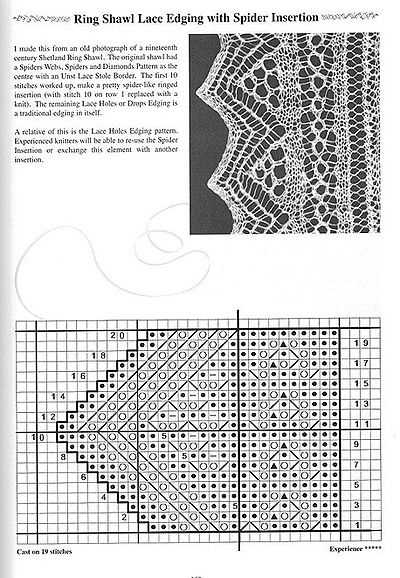
Decreases are often used in lace knitting to shape the edging and create the intricate patterns. Two commonly used decreases are the knit two together (k2tog) and slip, slip, knit (ssk). The k2tog decrease involves knitting two stitches together as one, while the ssk decrease involves slipping two stitches knitwise, then knitting them together through the back loops. These decreases create a slant in your knitting and help shape the lace design.
3. Charts:
Many lace edging patterns are presented in chart form rather than written instructions. Charts visually represent each stitch and its placement in the pattern. They can be easier to follow once you understand the symbols and how they correspond to different stitches. Practice reading and understanding lace charts to broaden your range of patterns and designs.
Incorporating these basic techniques into your lace knitting will allow you to create intricate and beautiful lace edging for your shawls. Experiment with different stitches, yarns, and patterns to discover your own unique style and create stunning finished pieces.
Adding lace edging to a shawl: step-by-step guide
Adding a knitted lace edging to a shawl can immediately transform it into an elegant and intricate piece. This step-by-step guide will walk you through the process of incorporating a lace edging into your shawl pattern.
1. Choose a lace edging pattern
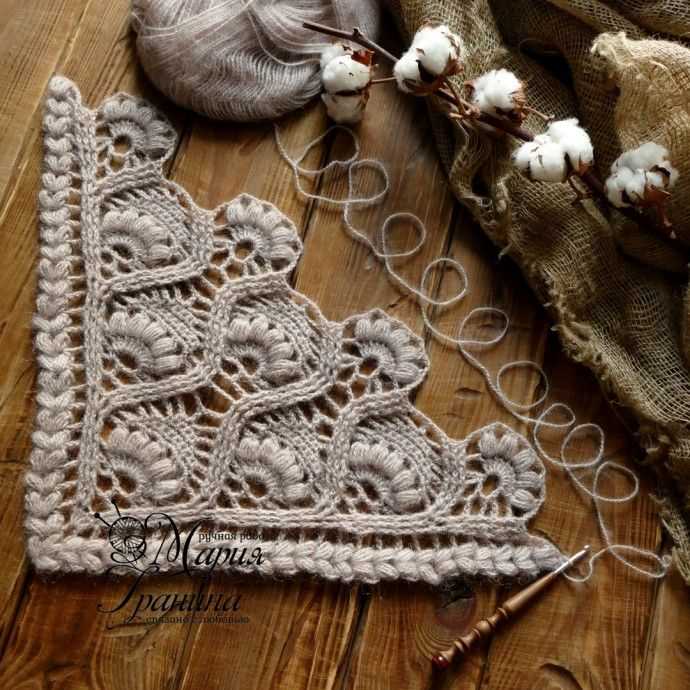
Start by selecting a lace edging pattern that complements the overall design of your shawl. There are numerous lace edging patterns available online or in knitting books. Consider the complexity of the pattern and how it will enhance the aesthetic of your shawl.
2. Determine the number of stitches needed
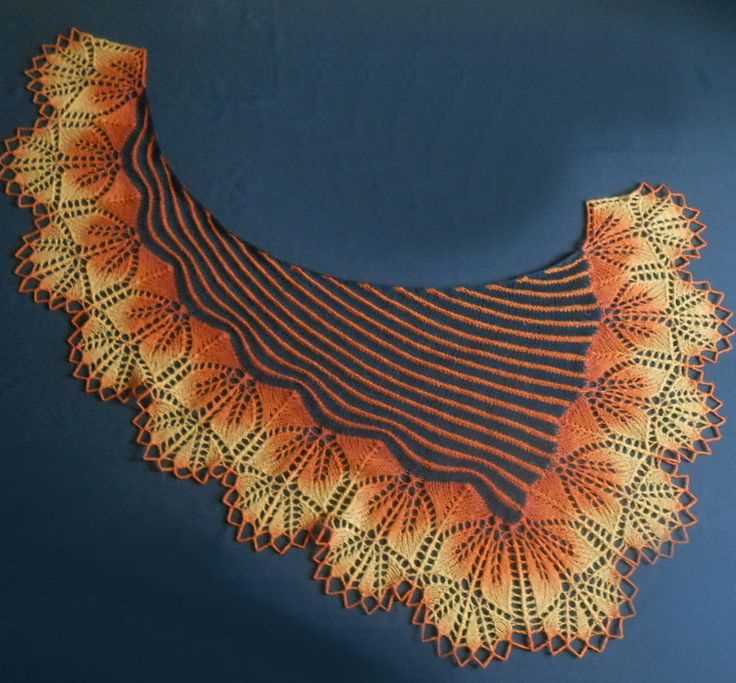
Measure the width of your shawl and calculate the number of stitches needed for the lace edging. Take into account any pattern repeats and borders to ensure the lace edging fits seamlessly with the body of the shawl.
3. Provisional cast-on
To join the lace edging to the shawl, use a provisional cast-on to create a temporary row of stitches. This will allow you to easily join the lace edging stitches to the live stitches of the shawl later on.
4. Knit the lace edging
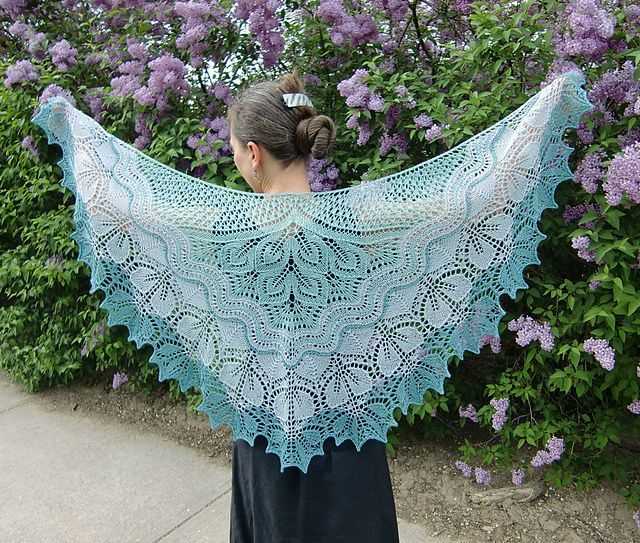
Follow the lace edging pattern instructions and knit the designated number of repeats or rows. Pay close attention to the stitch counts and any stitch variations required by the pattern. Take your time to ensure the lace pattern is coming out correctly.
5. Join the lace edging to the shawl
Once the lace edging is complete, it’s time to join it to the shawl. Retrieve the provisional cast-on stitches and place them on a spare needle. Then, using a knitting needle or crochet hook, gradually join the live stitches of the shawl to the lace edging, stitch by stitch.
6. Finishing touches
Once the lace edging is securely attached to the shawl, tidy up any loose ends or yarn tails. Block the shawl to help the lace pattern open up and showcase its intricate details. For the best results, follow the blocking instructions specific to your yarn and shawl design.
By following this step-by-step guide, you can easily add a beautiful lace edging to your shawl, elevating its elegance and making a statement piece for any occasion.
Blocking lace edging
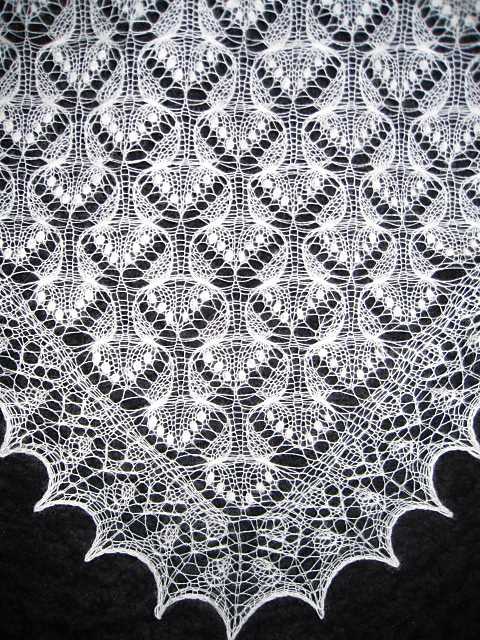
Blocking is an essential step in finishing a knitted lace edging for a shawl pattern. It helps to even out the stitches, open up the lace pattern, and give the edging its final shape and drape. To block lace edging, you will need a blocking mat or towel, pins, and a spray bottle filled with water.
Start by soaking the lace edging in cool water for about 15-20 minutes. Gently squeeze out the excess water, being careful not to wring or twist the fabric. Lay the wet lace edging on the blocking mat or towel, making sure it is in the desired shape and size.
Next, use the pins to secure the edges of the lace edging to the blocking mat, making sure to maintain the shape of the lace pattern. Pinning the corners and curves of the edging will help it hold its shape during drying. Use as many pins as necessary to keep the fabric flat and smooth.
Once the lace edging is pinned in place, use the spray bottle to lightly mist the fabric with water. This will help the stitches relax and open up the lace pattern. Allow the lace edging to dry completely before removing the pins. This may take several hours or even overnight.
After the lace edging is dry, carefully remove the pins and gently lift the edging from the blocking mat. The lace edging is now ready to be sewn onto the shawl or used as desired. Blocking not only enhances the appearance of the lace pattern but also helps to ensure that the finished shawl drapes beautifully.
Troubleshooting common lace knitting issues
Lace knitting can be a beautiful and intricate technique, but it can also present some challenges. Here are some common issues that knitters may encounter when working on lace patterns and how to troubleshoot them.
Mistakes in the pattern
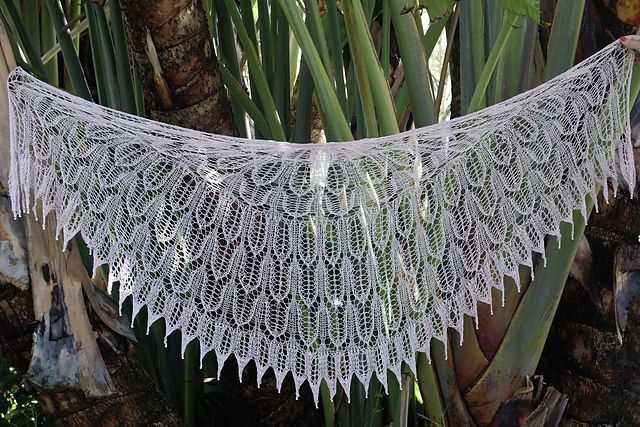
One of the most frustrating issues that knitters may come across is mistakes in the lace pattern itself. These mistakes can be in the form of incorrect stitch counts, missing or incorrect instructions, or confusing chart symbols. To avoid this issue, it is always a good idea to carefully read through the pattern before starting the project and make note of any potential errors. If you do come across a mistake while working on the pattern, you can try reaching out to the designer or checking online forums or knitting communities for possible solutions.
Uneven tension
Another common problem in lace knitting is uneven tension, where some areas of the lace appear tighter or looser than others. This can result in an uneven fabric and affect the overall look of the lace pattern. To avoid this issue, it is important to maintain a consistent tension throughout the project. You can achieve this by ensuring that your yarn is properly tensioned and keeping an eye on your knitting to make sure that your stitches are evenly spaced and not too tight or loose. If you notice uneven tension in your lace, you can try blocking the finished piece to even out the fabric or adjusting your tension as you knit.
Dropped stitches
Dropping a stitch in lace knitting can be a nightmare, as it can create a hole in the delicate lace fabric. If you drop a stitch while working on a lace pattern, it is important not to panic. You can use a crochet hook or a small knitting needle to carefully pick up the dropped stitch and bring it back up to the correct position. If the dropped stitch has caused a hole in the fabric, you can use a stitch marker or a bit of scrap yarn to secure the stitch until you can repair it properly. It’s always a good idea to regularly check your work as you knit to catch any dropped stitches early on.
Inconsistent stitch count
Having an inconsistent stitch count in a lace pattern can throw off the entire design and make it difficult to continue knitting. It is important to keep track of your stitch count and make sure that you haven’t accidentally added or dropped any stitches. If you notice that your stitch count is off, you can carefully go back and count your stitches to identify the mistake. You may need to tink back or frog a few rows to correct the issue, but it is better to catch it early on rather than continue knitting with an incorrect stitch count.
By being aware of these common issues and knowing how to troubleshoot them, you can successfully overcome challenges in lace knitting and create beautiful shawls and other lace garments.
Adding variations to lace edging patterns
In knitted lace edging patterns, there are several ways to add variations to make your shawl unique and personalized. By incorporating different stitch patterns, color changes, and shaping techniques, you can create a lace edging that stands out.
1. Stitch Patterns: Experiment with various stitch patterns to add texture and visual interest to your lace edging. You can include traditional lace stitches like yarn overs, decreases, and increases, or try more intricate patterns like cables, lace panels, or bobbles. Mixing and matching different stitch patterns can create a stunning effect.
2. Color Changes: Another way to add variation to your lace edging is by incorporating color changes. You can use multiple colors to create stripes or gradients, making the lace edging pop. Consider using high contrast colors for a bold look or subtle gradient shades for a more delicate effect. The color changes can be done through colorwork techniques like intarsia or stranded knitting.
3. Shaping Techniques: Shaping techniques can also be used to add variation to lace edging patterns. You can experiment with different increases and decreases to create interesting curves or angles in the edging. Adding shaping can give your shawl a unique silhouette and make it more flattering when worn.
4. Embellishments: Consider adding embellishments such as beads, sequins, or embroidery to your lace edging for added flair. These details can elevate the overall look of your shawl and make it truly one-of-a-kind. Beads can be added by pre-stringing them onto the yarn or using a crochet hook to add them as you go.
5. Altering the Scale: Finally, you can also add variation to lace edging patterns by altering the scale of the design. This can be done by adjusting the number of repeats or changing the size of the lace motifs. Making the lace edging larger or smaller can give it a completely different look and feel.
By incorporating these variations, you can create a lace edging that is unique to your shawl. Have fun experimenting with different stitches, colors, and shapes to make a statement with your knitted lace edging patterns.
Incorporating Beading into Lace Edging
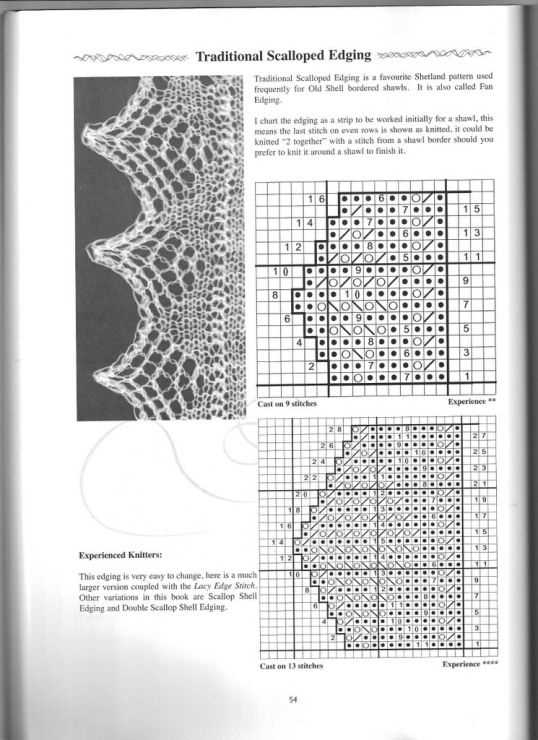
When it comes to adding an extra touch of elegance and sparkle to knitted lace edging, incorporating beads can be a stunning option. Beading not only adds visual interest, but it also adds weight and drape to the edging, making it more substantial and luxurious. There are several ways to incorporate beading into lace edging, each with its own unique effect.
Stringing Beads: One simple way to add beads to lace edging is by stringing them onto the yarn before knitting. This method involves threading the beads onto the yarn at regular intervals and then incorporating them into the lace pattern as you knit. The beads can be placed on the yarn individually or in groups, creating different effects depending on the desired design.
Picot Beading: Another popular technique for incorporating beads into lace edging is by using a picot stitch. Picots are small loops created in the knitting, and beads can be threaded onto these loops to add a decorative touch. This method works well with smaller beads and can create a delicate and intricate look.
- Beaded Cast-On: For a truly eye-catching lace edging, a beaded cast-on method can be used. This involves placing beads onto the yarn during the cast-on process, creating a row of beads along the edge of the shawl. This technique adds a beautiful detail to the starting edge and sets the tone for the entire piece.
- Post-Knitting Beading: In some cases, beads can also be added to lace edging after the knitting is complete. This can be done by threading a beading needle or crochet hook with yarn or thread and then stringing beads onto the edging stitches. This method allows for more precision and control over the bead placement.
By incorporating beading into lace edging, knitters can elevate the overall design of their shawls and create visually stunning and unique pieces. Whether it’s through stringing beads, using picot stitches, or employing beaded cast-on methods, the addition of beads adds an extra layer of beauty and intricacy to knitted lace edging.
Styling and wearing shawls with lace edging
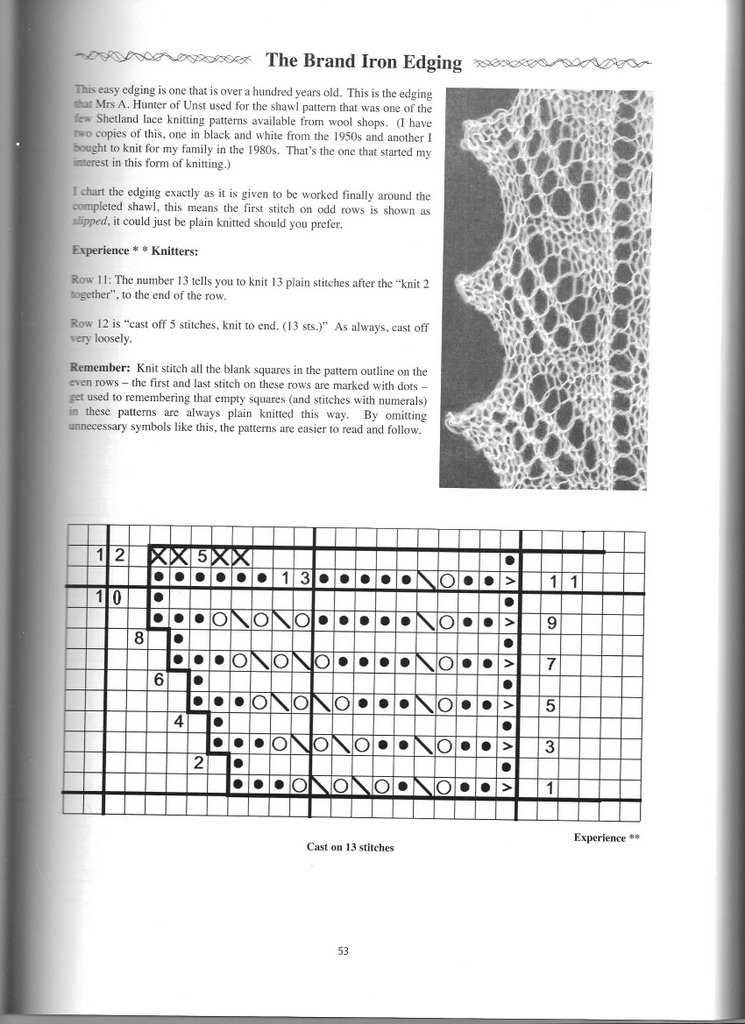
Shawls with knitted lace edging add an elegant touch to any outfit and can be styled in a variety of ways. Whether you are going for a casual or formal look, a shawl with lace edging can be a versatile accessory that adds flair to your outfit.
One popular way to wear a shawl with lace edging is to drape it over your shoulders. This creates a classic and sophisticated look that is perfect for formal occasions or evening events. It can be paired with a cocktail dress or an elegant gown to complete your ensemble. The intricate lace pattern adds a delicate and feminine touch to your outfit.
To achieve a more casual look, you can wear a shawl with lace edging as a wrap. Simply wrap it around your body and secure it with a belt for a chic and effortless style. This is a great option for a day spent shopping or a casual lunch with friends. The lace edging adds a touch of elegance to an otherwise simple outfit.
Another way to style a shawl with lace edging is to wear it as a scarf. Simply drape it around your neck and let the lace edging hang down. This creates a stylish and trendy look that can be paired with a sweater and jeans for a cozy and cute outfit. The lace edging adds a pop of texture and visual interest to your ensemble.
When it comes to choosing the right shawl with lace edging, consider the color and fabric. Neutral colors like white, cream, and black are versatile and can be paired with a variety of outfits. For a more bold and statement-making look, consider choosing a shawl with a vibrant or contrasting color.
In conclusion, shawls with knitted lace edging are a beautiful and versatile accessory that can be styled in a variety of ways. From draping it over your shoulders for a formal look to wearing it as a wrap or scarf for a more casual style, the options are endless. The lace edging adds an elegant and feminine touch to any outfit, making it a must-have accessory for any fashion-forward individual.